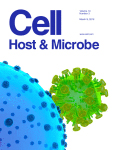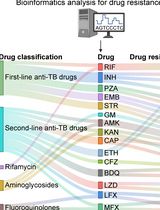- EN - English
- CN - 中文
Next-generation Sequencing of the DNA Virome from Fecal Samples
粪便样本中DNA病毒组的下一代测序法
发布: 2017年03月05日第7卷第5期 DOI: 10.21769/BioProtoc.2159 浏览次数: 10890
评审: Yannick DebingAnca Flavia SavulescuYi Zhang

相关实验方案

已表达前病毒的HIV-1包膜糖蛋白120 (gp120) 和nef基因的单基因组测序
David J. Nolan [...] Michael S. McGrath
2017年06月20日 9701 阅读
Abstract
Herein we describe a detailed protocol for DNA virome analysis of low input human stool samples (Monaco et al., 2016). This protocol is divided into four main steps: 1) stool samples are pulverized to evenly distribute microbial matter; 2) stool is enriched for virus-like particles and DNA is extracted by phenol-chloroform; 3) purified DNA is multiple-strand displacement amplified (MDA) and fragmented; and 4) libraries are constructed and sequenced using Illumina Miseq. Subsequent sequence analysis for viral sequence identification should be sensitive but stringent.
Keywords: Virome (病毒组)Background
The virome, a dynamic community of eukaryotic viruses, bacteriophages and endogenous retroviruses, represents a minimally characterized component of the human microbiome (Virgin, 2014). In fact, it is estimated that only 1% of the virome has been sequenced and annotated (Mokili et al., 2012). Next generation sequencing (NGS) enables examination of the entire virome, including unculturable viruses. Stool is a readily obtainable specimen type for study of the virome, and alterations in the fecal virome have been associated with a number of disease states (Handley et al., 2012; Norman et al., 2015; Monaco et al., 2016). The fecal virome is largely comprised of bacteriophages, which affect the gastrointestinal tract through alterations in bacterial functions and populations (Duerkop and Hooper, 2013; Reyes et al., 2013; Virgin, 2014). Enteric eukaryotic viruses, while less ubiquitous than bacteriophages, play a more direct role in gastrointestinal tract dysfunction by inducing gastroenteritis, enteritis and colitis. Despite the abundance of bacteriophages in fecal samples, only a few studies thus far have examined the contributions of fecal bacteriophages in human diseases. Inflammatory bowel disease has been associated with increased enteric bacteriophage richness (Norman et al., 2015). In contrast, profound immunosuppression from AIDS in a sub-Saharan cohort resulted in an expanded eukaryotic virome, but had minimal impact on bacteriophage populations (Monaco et al., 2016). More studies are needed to elucidate the role the fecal virome plays in disease states. A key roadblock to studying the stool virome is viral nucleic acid extraction and enrichment from fecal material. Several factors can contribute to difficulty in isolating viral sequences from fecal samples, chief among them the fact that viruses constitute a minority of fecal sample material. Additionally, dilution of feces in collection media (such as RNAlater RNA stabilization reagent) can further hamper the ability to find viral sequences. While many nucleic acid extraction protocols can be used for high input nucleic acid samples to enrich for viral nucleic acid, low input samples, such as those diluted in collection media, represent a challenge with virome studies. After comparison and optimization of several methods, the following protocol was identified as the most universally applicable for isolation of phage and DNA viral sequences from both low (Monaco et al., 2016) and high (Norman et al., 2015) input samples.
Materials and Reagents
- Stool aliquoting and pulverization
- Versi-dry sheets (Thermo Fisher Scientific, Thermo ScientificTM, catalog number: 74018-00 )
- Large Kim-wipes (KCWW, Kimberly-Clark, catalog number: 34721 )
- Extra heavy-duty aluminum foil (VWR, catalog number: 89107-734 )
- Dry ice
- Liquid nitrogen and a Dewar along with Styrofoam cup
- Pre-labeled screw capped tubes (STARSTEDT) in a freezer box (4 pre-labeled tubes per sample)
- Stool scrapers (autoclaved in sets of 6) (Fisher Scientific, catalog number: 21-401-25B )
- Sterilization pouches (small)
- Autoclave bags
- Bleach (5.25% solution of sodium hypochlorite)
- 75% EtOH
- Versi-dry sheets (Thermo Fisher Scientific, Thermo ScientificTM, catalog number: 74018-00 )
- Virus-like particle (vlp) preparation
- Sterile 1.5 ml and 2.0 ml screw-cap tubes
- 1 ml luer-lok syringes (BD, catalog number: 309628 )
- 0.45 µm filters 13 mm diameter (EMD Millipore, catalog number: SLHV013SL )
- 0.22 µm filters 13 mm diameter (EMD Millipore, catalog number: SLGV013SL )
- 1 M Tris, pH 7.5 (Fisher Scientific, catalog number: MT-46-030-CM ) (Tris 1 M pH 7.5, DNase-, RNase-, protease-free [6 x 1 L bottles])
- 5 M NaCl (Promega, catalog number: V4221 ) (5 M NaCl 1 L bottle, DNase-, RNase-, protease-free; aliquoted in 1 ml aliquots and stored at -20 °C)
- Saline magnesium (SM) buffer (Fisher Scientific, catalog number: 50-329-444 ) (SM buffer with gelatin pH 7.5, 100 ml)
- 10% SDS (diluted from 20% SDS stock [Thermo Fisher Scientific, AmbionTM, catalog number: AM9820 ] in RNase, DNase, Protease free H2O; aliquoted and stored at -20 °C)
- Lysozyme (10 mg/ml) (EMD Millipore, catalog number: 71412 ) – aliquoted and stored at -20 °C
- Turbo DNase I (2 U/µl) (Thermo Fisher Scientific, AmbionTM, catalog number: AM2238 )
- BaseLine zero DNase (1 U/µl) (Epicentre, catalog number: DB0711K )
- Chloroform (Fisher Scientific, catalog number: C298-500 )
- Phenol:chloroform:isoamyl alcohol (25:24:1) pH 8.0 (Fisher Scientific, catalog number: BP1752I-100 )
- QIAGEN DNeasy Blood and Tissue Kit (QIAGEN, catalog number: 69506 )
- CTAB (Sigma-Aldrich, catalog number: 52365 )
- CTAB/NaCl (see Recipes) [0.45 µm filtered + 0.22 µm filtered]
- Sterile 1.5 ml and 2.0 ml screw-cap tubes
- Library construction
- GenomiPhi V2 DNA Amplification Kit (GE Healthcare, catalog number: 25-6600-31 )
- Covaris microTUBE AFA fiber snap-cap 50 µl (Covaris, catalog number: 520045 )
- NEBNext® UltraTM DNA Library Prep Kit for Illumina (New England Biolabs, catalog number: E7370L , 96 rxns)
- NEBNext® Multiplex Oligos for Illumina®
Index Primers Set 1 (New England Biolabs, catalog number: E7335L )
Index Primers Set 2 (New England Biolabs, catalog number: E7500L ) - AMPure XP beads (Beckman Coulter, catalog number: A63881 )
- TE low EDTA
- D1K reagents (Agilent Technologies, catalog number: 5067-5362 )
- D1K screen tape for TapeStation (Agilent Technologies, catalog number: 5067-5361 )
- GenomiPhi V2 DNA Amplification Kit (GE Healthcare, catalog number: 25-6600-31 )
Equipment
- Biosafety hood
- 6 mortar/pestles, 100 ml capacity
- Beaker
- Microcentrifuge
- PCR hood
- -80 °C freezer
- Covaris E210
- PCR Thermocycler (Eppendorf)
- NanoDrop Micro-Volume UV-Vis spectrophotometer
- Agilent 2200 TapeStation (Agilent Technologies, model: 2200 TapeStation)
- Loading tips for TapeStation (Agilent Technologies, catalog number: 5067-5153 )
- DynamagTM-spin magnet (Thermo Fisher Scientific, catalog number: 12320D )
Procedure
文章信息
版权信息
© 2017 The Authors; exclusive licensee Bio-protocol LLC.
如何引用
Monaco, C. L. and Kwon, D. S. (2017). Next-generation Sequencing of the DNA Virome from Fecal Samples. Bio-protocol 7(5): e2159. DOI: 10.21769/BioProtoc.2159.
分类
微生物学 > 微生物遗传学 > DNA > DNA 测序
分子生物学 > DNA > 基因分型
系统生物学 > 基因组学 > 测序
您对这篇实验方法有问题吗?
在此处发布您的问题,我们将邀请本文作者来回答。同时,我们会将您的问题发布到Bio-protocol Exchange,以便寻求社区成员的帮助。
提问指南
+ 问题描述
写下详细的问题描述,包括所有有助于他人回答您问题的信息(例如实验过程、条件和相关图像等)。
Share
Bluesky
X
Copy link












